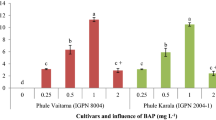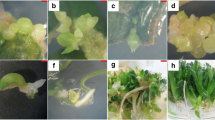Abstract
The objective of this study was to develop an efficient system for the regeneration of spinach plants (Spinacia oleracea L.) by investigating the factors influencing callus and shoot induction. All plant growth regulator (PGR) combinations tested induced callus with high frequency (73–100 %), and the combination of 5 μM α-naphthaleneacetic acid (NAA), 10 μM 6-benzyladenine (BA) and 0.1 μM gibberellic acid (GA3) had the most significant effect on callus growth in term of weight (120.98 ± 22.56 mg). A high auxin-containing medium induced competent callus for shoot formation, while high cytokinin-containing media enhanced callus growth and made callus incompetent for shoot regeneration. Longer periods of callus induction in a high auxin-containing medium were required to form competent callus and led to a high regeneration capacity. The PGR combination shift from a high auxin to cytokinin ratio (ACR) to a low ACR resulted in highly efficient regeneration. Among the regeneration systems tested, the combination of 10 μM NAA and 0.3 μM GA3 for callus induction for 6 weeks followed by 2 μM NAA and 5 μM BA resulted in the highest plant regeneration frequency (83.33 ± 6.43 %) and the highest number of plantlets per explant (7.93 ± 1.24). Somatic embryos at cotyledonary stage and plantlets were transferred to PGR-free medium to establish whole plants. Regenerated female plants grew well to maturity in the greenhouse (77.17 ± 9.80 %) and produced seeds (175.21 ± 28.01 firm seeds per plant).






Similar content being viewed by others
References
AI-Khayri JM, Huang FH, Morelork TE (1991) Regeneration of spinach from leaf callus. Hortic Sci 26:913–914
Al-Khayri JM, Huang FG, Morelock TE, Busharar TA (1992) In vitro plant regeneration of spinach from mature seed-derived callus. In Vitro Cell Dev Biol Plant 28:64–66
Bao JH, Chin DP, Fukami M, Ugaki M, Nomura M, Mii M (2009) Agrobacterium-mediated transformation of spinach (Spinacia oleracea) with Bacillus thuringiensis cry1Ac gene for resistance against two common vegetable pests. Plant Biotechnol 26:249–254
Chin DP, Bao JH, Mii M (2009) Transgenic spinach plants produced by Agrobacterium-mediated method based on the low temperature-dependent high plant regeneration ability of leaf explants. Plant Biotechnol 26:243–248
Geekiyanage S, Takase T, Watanabe S, Fukai S, Kiyosue T (2006) The combined effect of photoperiod, light intensity and GA3 on adventitious shoot regeneration from cotyledons of spinach (Spinacia oleracea L.). Plant Biotechnol 23:431–435
Ishizaki T, Komai F, Masuda K (2001) Screening for strongly regenerative genotypes of spinach in tissue culture using subcultured root explants. Plant Cell Tissue Organ Cult 67:251–255
Ishizaki T, Hoshino Y, Masuda K, Oosawa K (2002) Explants of Ri-transformed hairy roots of spinach can develop embryogenic calli in the absence of gibberellic acid, an essential growth regulator for induction of embryogenesis from non-transformed roots. Plant Sci 163:223–231
Knoll KA, Short KC, Curtis IS, Power JB, Davey MR (1997) Shoot regeneration from cultured root explants of spinach (Spinacia oleracea L.): a system for Agrobacterium transformation. Plant Cell Rep 17:96–101
Komai F, Okuse I, Harada T (1996a) Effective combinations of plant growth regulators for somatic embryogenesis from spinach root segments. J Jpn Soc Hortic Sci 65:559–564
Komai F, Okuse I, Harada T (1996b) Somatic embryogenesis and plantregeneration in culture of root segments of spinach (Spinacia oleracea L.). Plant Sci 113:203–208
Leguillon S, Charles G, Branchard M (2003) Plant regeneration from thin cell layers in Spinacia oleracea. Plant Cell Tissue Organ Cult 74:257–265
Mii M, Nakano M, Okuda K, Lizuka M (1992) Shoot regeneration from spinach hypocotyl segments by short term treatment with 5,6-dichloro-indole-3-acetic acid. Plant Cell Rep 11:58–61
Murashige T, Skoog F (1962) A revised medium for rapid growth and bioassays with tobacco tissue culture. Physiol Plant 15:473–497
Satoh T, Abe T, Sasahara T (1992) Plant regeneration from hypocotyl-derived calli of Spinach (Spinacia aleracea L.) and anatomical characteristics of regenerating calli. Plant Tissue Cult Lett. 9(3):176–183
Seaman A, Abawi G, Gugino BK, Helms M, McGrath M, Mohler CL, Rangarajan A, Tingey WM (2011) 2011 Production guide for organic spinach. New York State Integrated Pest Management Program. www.nysipm.cornell.edu/organic_guide/spinach.pdf. Accessed 25 April 2011
Shojaei T, Salari V, Ramazan D, Ehyaei M, Gharechahi J, Chaleshtori RM (2010) The effect of plant growth regulators, explants and cultivars on spinach (Spinacia oleracea L.) tissue culture. Afr J Biotechnol 9(27):4179–4185
Skoog F, Miller CO (1957) Chemical regulation of growth and organ formation in plant tissues cultured in vitro. Symp Soc Exp Biol 11:118–131
Xiao XG, Branchard M (1993) Embryogenesis and plant regeneration of spinach (Spinacia oleracea L.) from hypocotyl segments. Plant Cell Rep 13:69–71
Xiao XG, Charles G, Branchard M (1997) Plant regeneration from cell suspensions of spinach. Plant Cell Tissue Org Cult 49:89–92
Yang YM, Al-Khayri JM, Anderson EJ (1997) Transgenic spinach plants expressing the coat protein of cucumber mosaic virus. In Vitro Cell Dev Biol Plant 33:200–204
Zdravković-Korać S, Nešković M (1999) Induction and development of somatic embryos from spinach (Spinacia oleracea) leaf segments. Plant Cell Tissue Organ Cult 55:109–114
Zhang HX, Zeevaart JAD (1999) An efficient Agrobacterium tumefaciens-mediated transformation and regeneration system for cotyledons of spinach (Spinacia oleracea L.). Plant Cell Rep 18:640–645
Acknowledgments
This work was supported by the grants from Priority Research Centers Program (2011-0030748) and Mid-career Researcher Program (2011-0027519) through the National Research Foundation of Korea (NRF) funded by the Ministry of Education, Science and Technology, and the Next-Generation BioGreen 21 Program (SSAC, PJ008122; TAGC, PJ009094), Rural Development Administration, Republic of Korea.
Author information
Authors and Affiliations
Corresponding authors
Additional information
Q. V. Nguyen, H. J. Sun and K. H. Boo contributed equally to this work.
Rights and permissions
About this article
Cite this article
Nguyen, Q.V., Sun, H.J., Boo, K.H. et al. Effect of plant growth regulator combination and culture period on in vitro regeneration of spinach (Spinacia oleracea L.). Plant Biotechnol Rep 7, 99–108 (2013). https://doi.org/10.1007/s11816-012-0242-3
Received:
Accepted:
Published:
Issue Date:
DOI: https://doi.org/10.1007/s11816-012-0242-3




